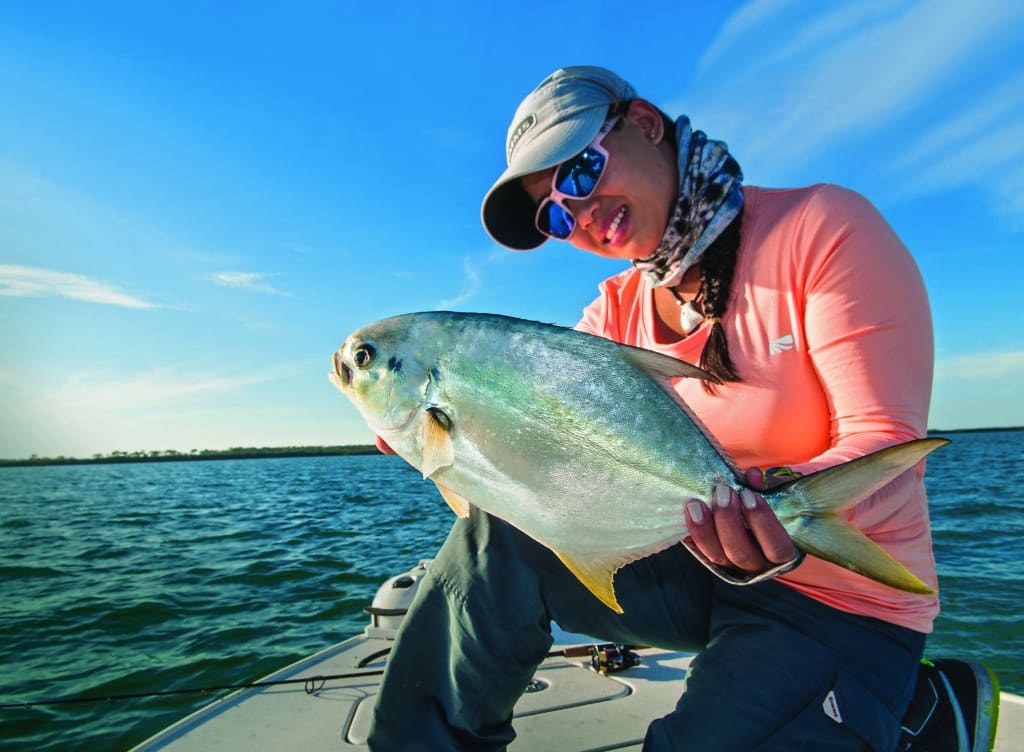
The website dictionary.com defines game fish as a noun meaning an edible fish capable of affording sport to the angler in its capture. If you accept that definition, the Florida pompano, a member of the jack family of fishes, qualifies as one of the top game fish of all time. Although it lacks the cachet of permit, its larger cousin, pompano are strong, fast and an exciting challenge on light tackle and fly gear. They are also delicious.
Anglers soaking sand fleas and shrimp in beach troughs consistently score these silvery jacks, but the real test entails hunting and casting to individual targets. Captains Ed Zyak and Baz Yelverton are top pompano sight-casting experts on their respective coasts and they offered their professional advice.
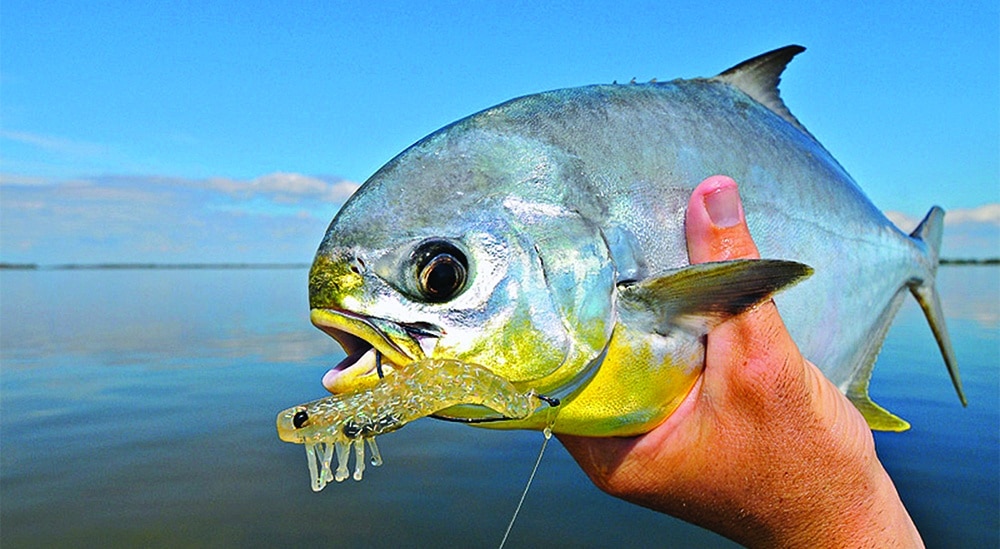
Southeast Approach
Zyak, a Jensen Beach, Florida, guide for the past 17 years, says pompano first arrive in the Stuart area with the winter cold fronts, moving in and out the inlets as the water temperature fluctuates. Once the temperatures settle in the low- to mid-70s, they leave the deeper water to forage on the shallow flats near the inlets, Zyak explains. “And depending on how cold it gets, they’ll typically stay here in good numbers through April.”
“There’s nothing better than sight-fishing. It’s my favorite method for pompano,” he says. “I always start looking on incoming tides. That’s when you get the cleaner water.”
When wind and sun cooperate, he prefers to exit the boat and wade to optimize his chances with wary fish in water thigh-deep or less.
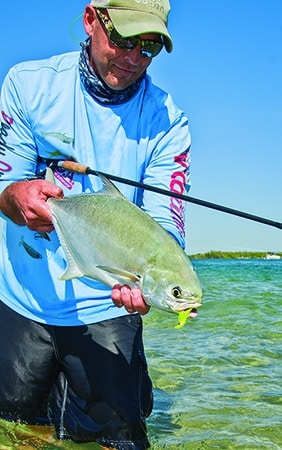
Locate and Present
“Generally, you never see the whole fish,” he says. “I’m looking for reflections from the sun hitting it. Waves or boat wakes rolling across the bar also cut the glare and let you see better. You look for an iridescent flash or shine. They really light up on that golden sand bottom. Typically, you see the shadow of the fish, rather than the body itself.” Zyak says South Florida flats pompano travel solo or in small groups of four to five fish. Sizes range from 3 to 4 pounds on average.
“Occasionally you’ll get a 6-pounder on the bar, and they’ll just scream when you hook ’em,” Zyak adds.
Armed with medium-action spinning rods with light tips, Zyak’s favorite sight-cast lure is a chartreuse 2-inch DOA shrimp body pinned on a 1⁄16-ounce chartreuse jig head. Despite the tiny size, the plastic/jig combo casts long distances and produces the desired effect.
“Even though the water may be knee-deep, that lure gets to the bottom and puffs up sand when you twitch it. That’s the key. These fish are used to eating things that take off and leave a puff of dirt. You want to cast ahead of the fish and then move the shrimp as they get close. Then they’re all over it.”
Zyak has tallied as many as 13 sight-cast pompano on days when conditions were right and the fish were aggressive. Bright sunlight (after 10 a.m. is the best angle), clear water and little to no wind are optimal.
“If you want to load up, you can go to deeper water and tip a jig with shrimp,” Zyak says. “But I enjoy sight-fishing so much more. I’d rather watch them eat and catch five on that little shrimp lure or a 7-weight fly rod. It’s a ton of fun.”
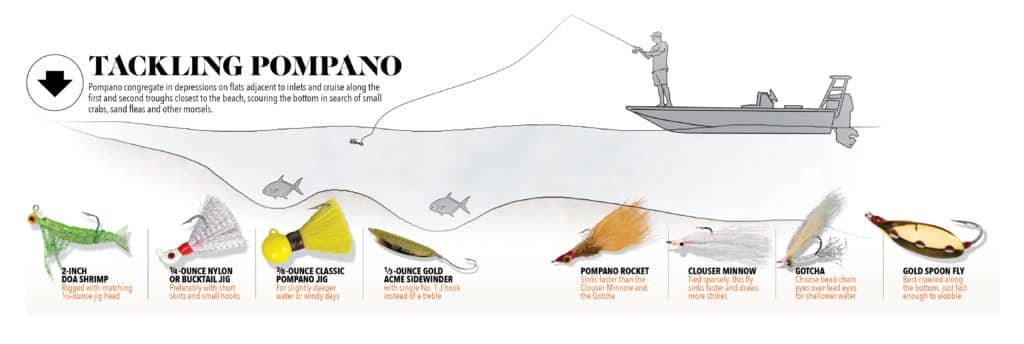
Gulf Coast Fishing Style
At the opposite end of the state, Baz Yelverton also uses light-tackle spinning gear and bucktail jigs or small gold spoons to entice Gulf pompano along the Panhandle beaches near Pensacola. But given his druthers, this veteran guide and his clients prefer fooling fish with feathers and fur.
“Pompano are so hard to see. That’s part of the allure,” Yelverton says. “You’ll spot one coming at you from a distance, then it turns sideways; the light reflects off the bottom, and the fish just disappears. Then it’ll turn a certain way and appear again. Pompano really are my favorite species. They are beautiful, challenging and adorable. And they’ll put up a doggone good fight, just like any jack.”
Springtime Endeavor
Pompano appear along the Florida Panhandle in late February once water temperatures range between 62 and 65 degrees. Big, solitary fish arrive first, but once the water reaches 70 degrees, or about the same time the azaleas and dogwoods start blooming in late March or early April, schools migrate west down the beach. The fish are usually bunched in small groups of a dozen or fewer, but numbers can sometimes approach triple digits.
“Full-moon tides push the fish right up to the beach to avoid predators, sometimes just 3 feet off the sand,” says Yelverton. “The best days are when there’s just a little bit of shore break. That agitation stirs up the sand fleas and they tumble down into the troughs. Pompano also love surf pockets. They hold in those depressions or indentations and wait for food to wash along.”
Pompano on Fly
Yelverton says fly-casts need to be 50 feet or longer. “It’s not for the beginner,” he says. “It sure is fun, though. When conditions are right, you can get in real close and see the fish as it races over and eats. On a fly, that’s the ultimate.”
Eight-weight outfits are perfect for fly-fishing pompano. Yelverton uses weight-forward floating lines with a braided core, matched with 10-foot tapered leaders with a 2-foot, 15-pound fluoro tippet. The fly is attached with a nonslip loop knot.
Although he’s caught fish on pink Clousers and Gotcha patterns, Yelverton has better luck with the locally designed Pompano Rocket, a 11⁄4-inch pattern with gold eyes, red thread and yellow plumage with a bit of gold flash.
“I’ve tried various sand-flea flies but haven’t had any success with them,” Yelverton explains. “I always go back to the Rocket. It’s all about where you put the fly and what you do with it anyway.” Pompano have big eyes and excellent vision, so they respond best to erratic 2-inch strips, Yelverton has found. His best fly trip was nine fish in one morning. “You still get a lot of refusals. Sometimes they won’t eat, no matter what color you’re throwing or how you work the fly. Landing one is always an exciting moment on the boat.”
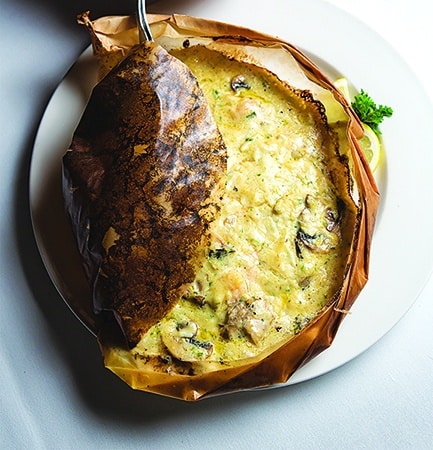
On the Table
Although more pompano are released these days, the food value is exceptional with a mild flavor and white flaky flesh. Grilled pompano with a favorite marinade is a popular choice. Another alternative is to leave the skin on and lightly cover the sides with a thin layer of mayonnaise. Sprinkle rock salt over the coating and then wrap in parchment paper and bake 30 minutes at 425 degrees. The mayonnaise and salt form a hard crust that seals in the moisture and is easily peeled away before serving.









